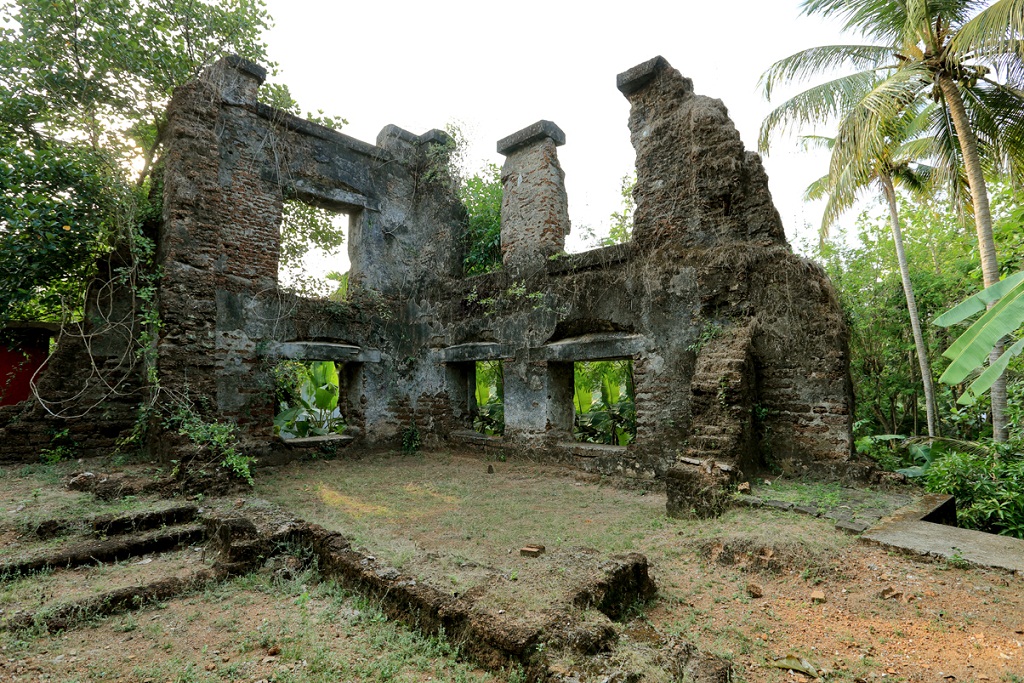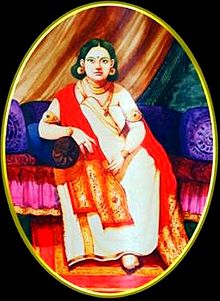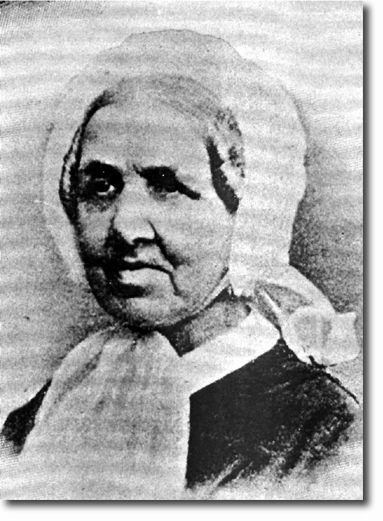One day, when Ubhaya Bharati was going to the river for a bath with her women disciples, she saw an ascetic, who had renounced everything in life, sleeping on the wayside, resting his head on a hollow water jug, using it as a pillow and at the same time ensuring that nobody took it away. As long as you have attachment and ego, you can never understand the Atma or experience atmic bliss.
In order to convey a lesson to the ascetic, Ubhaya Bharati spoke within his hearing the following words to one of her disciples: "Look at that ascetic, who has ostensibly renounced every kind of attachment, but he has not given up his attachment to his water jug!" On hearing these words, the ascetic got enraged. He thought: "Is a mere woman entitled to teach me as to how I should behave." While Ubhaya Bharati was returning from the river, the ascetic threw the jug at her feet and said: "Now, see what my renunciation is?" Ubhaya Bharati remarked: "Alas! You are not only filled with attachment (abhimana) but you are also filled with ego (ahamkara)." On hearing these words, the ascetic ran up to her, fell at her feet and pleaded for forgiveness of his faults.
Dr.Ananth Sadhashiv Altekar in his Book , “Position of Women in Hindu Civilization” ( Motilal Banarasi Das,Delhi ,1959 & 1987) states that he quotes this information from a Sanskrit Text “Sarvaanukkraamaanika”. Those Women,who did not marry -for whom God “Revealed” the authoritative Hindu Scripture, VEDAM and doing religious service,were called “Brahma Vaadhins”.The last names for them are their father’s names. Those who were married to whom “Vedam” was “revealed” and were doing religious Srevice were called “Saadhya Vadhus “.
Dr.Altekar says that according to another Sanskrit Text, Kaasakritsanaas ( Maha Bhaashya),“ Poorva Meemamsa is more Abstruse than Mathematics “.A very large number of Ladies were Adept in Poorva meemaamsa “. Gaargi Vaachana Kavi,daughter of Sage Garg, Sulabha Maithreyi (daughter of Sage Mithra) and wife of Sage Yaagjnavalkya, Vaadhavi Praathatheyi are examples.Poorva Meemamsa is one that doesn't recognize Vedanta,with emphasis on Karma or action.
Vedam was “revealed” to women scholars -women taught Vedam to men Scholars.In Kerala,Manorama Thampuratti of Kottakkal Palace,a Sanskrit scholar,taught men during the time of Travancore King,Dharmaraja.
Ubhaya Bharathi was appointed as “Adjudicator” (Judge/Arbiter) in the Religious debate between Sankara and Mandana Misra, two Intellecual giants,and in the debate she was the third intellectual giant in Hindu Scripures (788 to 820 A.D.).My short story,Parakaya Pravesam is based on that debate,where in Bharati is said to have belittled Sankara for absence of sexual experience.Bharathi got the sobriquet Ubhaya,since she was expert in both Meemamsa a nd Brahma Vidya.
Maṇḍana and Sankara agreed that Maṇḍana's wife Ubhaya Bharati, who is considered to be an incarnation of the goddess Saraswati in the folklore of Mithila, would be the arbiter for the debate, and that the vanquished would become a disciple of the victor and accept his school of thought. The debate spanned many days and ranged across many different subjects within the Vedas, and the arguments of both competitors were compelling and forceful. Sankara finally emerged victorious. But Maṇḍana's wife, who was the judge, would not accept an ascetic as having complete knowledge since he did not have any knowledge about Kama sastras (rules about marital life). Sankara was then given six months to research certain aspects of sex-love sciences and then resume the debate. According to legend, he entered into the body of Amaruka, king of Kashmir who had just died to learn these sciences. Later, after obtaining the necessary knowledge, the debate resumed. There is a poetic work,Amaruka Sathaka.After a long debate, Maṇḍana accepted defeat.There is a legend that the place of debate between Sankaracharya and Mandanmisra, was the town Mandleshwar near Maheshwar in Bihar. The ancient temple Chhapan Deo of this town is considered to be this place.But Mahishmati, is at the confluence of the Narmada and Mahishmati rivers, near Omkareshwar,Madhya Pradesh.
Scholars usually doesn't accept the kamasasthra aspect of Sankara-Bharati debate,and Nochur Venkataraman too has avoided it in his biography of Sankara.From his book,one learns that Ubhaya Bharati,who became a disciple of Sankara,accompanied him to Sringeri,and stayed there forever after Acharya consecrated the Sarada temple there.
Gargi Vachaknavi (born about c. 7th century BCE) was an ancient Indian philosopher. In Vedic literature, she is honored as a great natural philosopher,renowned expounder of the Vedas, and known as Brahmavadini, a person with knowledge of Brahma Vidya.In the Sixth and the eighth Brahmana of Brihadaranyaka Upanishad, her name is prominent as she participates in the brahmayajna, a philosophic debate organized by King Janaka of Videha and challenges the sage Yajnavalkya with perplexing questions on the issue of atman (soul). She is also said to have written many hymns in the Rigveda. She remained a celibate all her life and was held in veneration by the conventional Hindus.
Gargi, the daughter of sage Vachaknu in the lineage of sage Garga (c. 800-500 BCE) was named after her father as Gargi Vachaknavi. From a young age she evinced keen interest in Vedic scriptures and became very proficient in fields of philosophy. She became highly knowledgeable in the Vedas and Upanishads in the Vedic times and held intellectual debates with other philosophers.
Gargi, along with Vadava Pratitheyi and Sulabha Maitreyi are among the prominent females who figure in the Upanishads. She was as knowledgeable in Vedas and Upanishads as men of the Vedic times and could very well contest the male-philosophers in debates.Her name appears in the Grihya Sutras of Asvalayana. She had even awakened her Kundalini (indwelling spiritual energy). A realized soul.She was a leading scholar who also made rich contributions to propagate education.
According to Brihadaranyaka Upanishad, King Janaka of Videha Kingdom held a Rajasuya Yagna and invited all the learned sages, kings and princess of India to participate. The yagna lasted for many days. Large quantities of sandalwood, ghee (clarified butter) and barley (cereal grain) were offered to the Yagna fire creating an atmosphere of spiritual sanctity and aroma. Janaka himself being a scholar was impressed with the large gathering of learned sages. He thought of selecting a scholar from the assembled group of elite scholars, the most accomplished of them all who had maximum knowledge about Brahman. For this purpose, he evolved a plan and offered a prize of 1,000 cows with each cow dangled with 10 grams of gold on its horns. The galaxy of scholars, apart from others, included the renowned sage Yajnavalkya and Gargi Vachaknavi. Yajnavalkya, who was aware that he was the most spiritually knowledgeable among the assembled gathering, as he had mastered the art of Kundalini Yoga, ordered his disciple Samsrava to drive away the cow herd to his house. This infuriated the scholars as they felt that he was taking way the prize without contesting in a debate. Some of the local pundits (scholars) did not volunteer for debate with him as they were not sure of their knowledge. However, there were eight renowned sages who challenged him for a debate, which included Gargi, the only lady in the assembled gathering of the learned.

Sages like Asvala, the priest in Janaka's court, Artabhaga, Bhujyu, Ushasta, and Uddalaka debated with him and asked questions philosophical subjects to which Yajnavalkya provided convincing replies and they lost the debate. It was then the turn of Gargi to take up the challenge. Gargi, as one of the disputants in the debate, questioned Yajnavalkya on his claim of superiority among the scholars. She held repeated arguments with him. Gargi and Yajnavalkya's exchange centered on the ultimate "warp" of reality ("warp" means "the basic foundation or material of a structure or entity). Her initial dialogue with Yajnavalkya tended to be too metaphysical, such as unending status of the soul, away from practical situations. She then changed her approach and asked him pointed questions related to the environment existing in the world, the question of the very origin of all existence. Her question was specific when she asked him "since this whole world is woven back and forth on water, on what then is woven back and forth", a question that related to the commonly known cosmological metaphor that expressed the unity of the world, its essential interconnectedness. In the Brihadaranyaka Upanishad (3.6), the sequence of her posing a bevy of questions to Yajnavalkya and his replies is narrated as
Her philosophical views also find mention in the Chandogya Upanishad.Gargi, as Brahmavadini, composed several hymns in Rigveda (in X 39. V.28) that questioned the origin of all existence. The Yoga Yajnavalkya, a classical text on Yoga is a dialogue between Gargi and sage Yajnavalkya. Gargi was honoured as one of the Navaratnas (nine gems) in the court of King Janaka of Mithila.
Maitreyi ("friendly one"was an Indian philosopher who lived during the later Vedic period in ancient India. She is mentioned in the Brihadaranyaka Upanishad as one of two wives of the Vedic sage Yajnavalkya; he is estimated to have lived around the 8th century BCE. In the Hindu epic Mahabharata and the Gṛhyasūtras, however, Maitreyi is described as an Advaita philosopher who never married. In ancient Sanskrit literature, she is known as a brahmavadini (an expounder of the Veda).She is Sulabha in Mahabharata.
Maitreyi appears in ancient Indian texts, such as in a dialogue where she explores the Hindu concept of Atman (soul or self) in a dialogue with Yajnavalkya in the Brihadaranyaka Upanishad. According to this dialogue, love is driven by a person's soul, and Maitreyi discusses the nature of Atman and Brahman and their unity, the core of Advaita philosophy. This Maitreyi-Yajnavalkya dialogue is the topic of Sureshvara's varttika, a commentary.
Maitreyi is cited as an example of the educational opportunities available to women in Vedic India, and their philosophical achievements.
In the Asvalayana Gṛhyasūtra, the daughter of the sage Maitri is referred to as Sulabha Maitreyi and is mentioned in the Gṛhyasūtras with several other women scholars of the Vedic era.Her father, who lived in the Kingdom of the Videhas, Mithila, was a minister in the court of King Janaka.
Although Maitreyi of ancient India, described as an Advaita philosopher, is said to be a wife of the sage Yajnavalkya in the Brihadaranyaka Upanishad in the time of Janaka, the Hindu epic Mahabharata states Sulabha Maitreyi is a young beauty who never marries. In the latter, Maitreyi explains Advaita philosophy (monism) to Janaka and is described as a lifelong ascetic.
In the Brihadaranyaka Upanishad, Maitreyi is described as Yajnavalkya's scholarly wife; his other wife, Katyayani, was a housewife.While Yajnavalkya and Katyayani lived in contented domesticity, Maitreyi studied metaphysics and engaged in theological dialogues with her husband in addition to "making self-inquiries of introspection".
In the Rigveda about ten hymns are attributed to Maitreyi.She explores the Hindu concept of Atman (soul or self) in a dialogue contained in the Brihadaranyaka Upanishad. The dialogue, also called the Maitreyi-Yajnavalkya dialogue, states that love is driven by a person's soul, and it discusses the nature of Atman and Brahman and their unity, the core of Advaita philosophy.
This dialogue appears in several Hindu texts; the earliest is in chapter 2.4 – and modified in chapter 4.5 – of the Brihadaranyaka Upanishad, one of the principal and oldest Upanishads, dating from approximately 700 BCE. The Maitreyi-Yajnavalkya dialogue has survived in two manuscript recensions from the Madhyamdina and Kanva Vedic schools; although they have significant literary differences, they share the same philosophical theme.
After Yajnavalkya achieved success in the first three stages of his life – brahmacharya (as a student), grihastha (with his family) and vanaprastha (in retirement) – he wished to become a sannyasi (a renunciant) in his old age. He asked Maitreyi for permission, telling her that he wanted to divide his assets between her and Katyayani. Maitreyi said that she was not interested in wealth, since it would not make her "immortal", but wanted to learn about immortality: In the dialogue which follows, Yajnavalkya explains his views on immortality in Atman (soul), Brahman (ultimate reality) and their equivalence. Maitreyi objects to parts of Yajnavalkya's explanation, and requests clarification.

Scholars have differing views on whether this dialogue is evidence that in ancient Vedic tradition women were accepted as active participants in spiritual discussions and as scholars of Brahman. Wendy Doniger, an American Indologist and a professor of History of Religions, states that in this dialogue Maitreyi is not portrayed as an author, but is part of an Upanishadic story of a Brahmin with two wives who are distinguished by their intellect. Karen Pechelis, another American Indologist and a professor of Comparative Religion, in contrast, states that Maitreyi is portrayed as theologically minded, as she challenges Yajnavalkya in this dialogue and asks the right questions.
First-millennium Indian scholars, such as Sureshvara (Suresvaracharya, c. 750 CE), have viewed this male-female dialogue as profound on both sides; Maitreyi refuses wealth, wishing to share her husband's spiritual knowledge, and in the four known versions of the Upanishadic story she challenges Yajnavalkya's theory of Atman. Yajnavalkya acknowledges her motivations, and that her questions are evidence she is a seeker of ultimate knowledge and a lover of the Atman.
The Maitreyi dialogue in the Upanishad is significant beyond being a gage of gender relations. Adi Shankara, a scholar of the influential Advaita Vedanta school of Hindu philosophy, wrote in his Brihadaranyakopanishad bhashya that the purpose of the Maitreyi-Yajnavalkya dialogue in chapter 2.4 of the Brihadaranyaka Upanishad is to highlight the importance of the knowledge of Atman and Brahman, and to understand their oneness. According to Sankara, the dialogue suggests renunciation is prescribed in the Sruti (vedic texts of Hinduism), as a means to knowledge of the Brahman and Atman. He adds, that the pursuit of self-knowledge is considered important in the Sruti because the Maitreyi dialogue is repeated in chapter 4.5 as a "logical finale" to the discussion of Brahman in the Upanishad.
The Maitreyi-Yajnavalkya dialogue includes a discussion of love and the essence of whom one loves, suggesting that love is a connection of the soul and the universal self (related to an individual): German Indologist and Oxford University professor Max Müller says that the love described in the Maitreyi-Yajnavalkya dialogue of the Brihadaranyaka Upanishad extends to all aspects of one's life and beyond; in verse 2.4.5, "The Devas (gods) are not dear to one out of love for gods, but because one may love the Self (Atman) that the gods are dear". In the dialogue "the Brahman-class, the Kshatra-class, these worlds, these gods, these beings, everything that is what this Soul is", and when "we see, hear, perceive and know the Self, then all is known".
Concluding his dialogue on the "inner self", or soul, Yajnavalkaya tells Maitreyi: After Yajnavalkya leaves and becomes a sannyasi, Maitreyi becomes a sannyassini – she too wanders and leads a renunciate's life.
Apart from these five following names of women scholars are mentioned in the Vedas:
Godha: Name of the authoress of a Sāman Source
Visvavara: Name of the authoress of the hymn RV 5.28
Apala: Name of the authoress of the hymn RV 8.91
Upanisat
Nisat
Juhu Brahmajaya: Name of the authoress of the hymn RV 10.109
Agastyasya
Aditi: Name of the authoress of the hymn RV 4.18
Indrani: Name of the authoress of the hymn RV 10.86
Indramata
Sarama: Name of the reputed authoress of RV 10.108
Romasa: Name of the reputed authoress of RV 1.126,7
Oorvasi
Nadya
Yami
Sasvati: Name of the authoress of RV 8.1
Sri Lakshaa
Sarparajni
Vak
Sraddha
Medha
Daksina: Name of the authoress of RV 10.107
Ratri
Surya Savitri: Name of the authoress of RV 10.85
Vasukrapatni: Name of the authoress of the verse RV 10.28.1
R. L. Kashyap in Essentials of Rig Veda lists about 30 ṛṣhikās (women seers of Rigveda) along with the verse numbers. The author also notes the list is not exhaustive.Appendix Women Ṛṣhis (ṛṣhikā) in the Rig Veda Samhitā Aditi 4.18 Aditirdākshāyaṇī 10.72 Agastyasvasā 10.60.6 Apālā Ātreyī 8.91 Dakshiṇā Prājapatyā 10.107 Godhā 10.134 Goṣhā Kākshīvatī 10.39, 10.40 Indrāṇī 10.86, 10.145 Indra-mātaraḥ 10.153 Jaritā Sharṇgā 10.142 Juhūrbrahmajāyā 10.109 Kāshyapī 9.104 Lopāmudrā 1.179 Rātrīrbhāradvājī 10.127 Romashā 1.126 Suryā Sāvitrī 10.85 Saramā Devashunī 10.108.Sārparājnī 10.189 Sashvatyāṇgīrasī 8.1 Shachī Paulomī 10.159 Shradhdā Kāmāyānī 10.151 Sikatā Nivāvarī 9.86 Sudītīrangirasā 8.71 Tvaṣhṭa Garbhakartā 10.184 Urvashī 10.95 Vāgambhṛṇī 10.125 Vasukrapatnī 10.28 Vishvavārā Ātreyī 5.28 Yamī Vaivasvatī 10.10 Yamī 10.154.
















